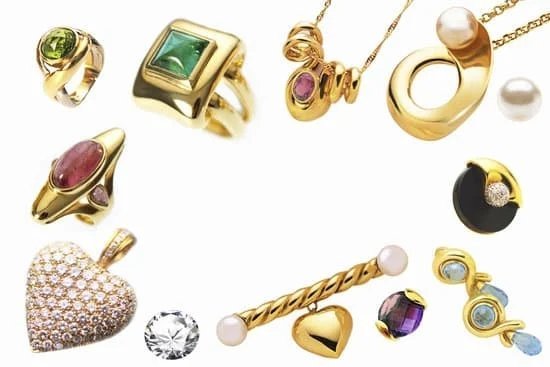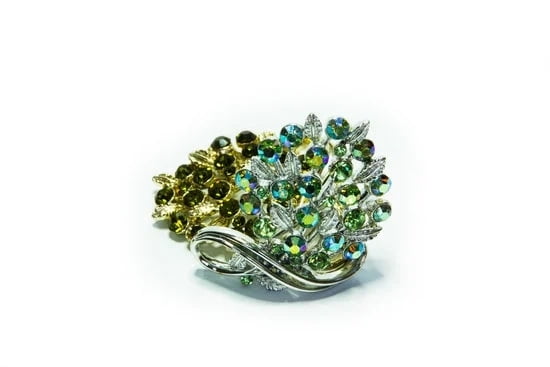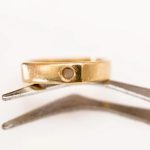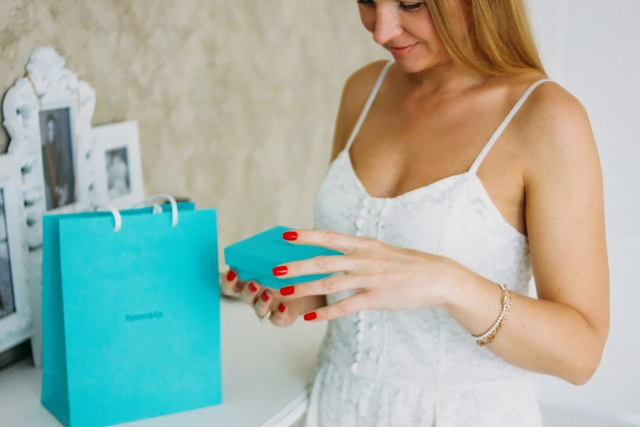The primary purpose of lacquer on jewelry is as a protection to prevent oxidation of the precious metals. The lacquer also adds an extra level of sheen and shine, making it look better. However, over time the lacquer may become damaged or wear down and eventually strip away.
This can happen due to many factors, including exposure to moisture, abrasive cleaners and normal wear-and-tear. After the lacquer has been stripped you may notice tarnishing or discoloration on the jewelry which is caused by oxidation.
Identifying A Stripped Piece Of Jewelry – Explaining how to visually identify if a piece of jewelry has become stripped of its lacquer
Once lacquer has been stripped from your jewelry, it can be quite obvious; however it doesn’t always stand out clearly. One way to check for this is to place some vinegar or lemon juice on a cloth and gently rub in onto an area of the jewelry that isn’t visible when worn – this should cause a reaction if the lacquer has gone as it will leave a black discoloration behind.
Additionally, you may notice blemishes that aren’t polished, patches where more dull areas are found and different coloration than when first purchased due to tarnishing. Lastly looked for individual beads, pieces or components consisting of gold or silver tones that may have lost their previous appearance after being stripped from the protective layer.
Repairing The Jewelry – Explaining what materials are needed for repair and how proceed with repair in detail
Once you have identified an item as having been stripped of its lacquer there are a few steps you can take to repair it at home without professional help. First you will need some soft bristle brush (e.g., toothbrush), warm water, mild soap solution, soft damp cloths, toothpicks and high-grade paste wax (colorless).
Begin by rinsing off any loose dirt before scrubbing away any more craft dirt with your chosen brush but do so lightly as not to scratch the surface too harshly.
Next mix some warm water with just enough soap solution until a lather is formed and dip your brush into this before running it softly against the piece hoping you won’t need finer detailing tools such as toothpicks just yet but they may come in handy later down the line if dirt become harder to remove.
To finish up use a damp cloth removing all abrasive particles discharging excess lather before polishing well with cheesecloth soaked in high-grade wax; allow drying for two minutes before wiping off remainder excess wax with a dry cloth lastly rinsing with hot water finishing off by drying off standing alone in open airy space overnight etc.
Materials Needed
Jewelry that contains lacquer can often become worn off with daily wear. Such pieces will then require a bit of extra effort to restore and protect the item so that it may be worn for many years to come. With the right materials, any jewelry repair can be completed with ease in no time at all.
The first step when repairing jewelry that is stripped of lacquer is to ensure you have the necessary materials. A list of items includes something to clean the piece, such as rubbing alcohol or soap and water; a soft cloth; tweezers; lint-free rags; a cotton bud (or Q-Tip); and lacquer or a clear coat finish spray paint specifically designed for metals and gems. All of these items should be available from any craft or hardware store.
After gathering your supplies, start by gently cleaning the item with your chosen cleaning solution. Rubbing alcohol works best as it does not contain water which could damage delicate metal components in some pieces over time.
Use a soft cloth, taking extra care not to scrub too hard or use anything abrasive which may cause additional damage. Carefully remove any dirt or residue from the ruined lacquer using tweezers and a lint-free rag where necessary, paying close attention not to cause any additional scratches on its surface.
Once the piece is free of dirt and debris, use the Q-Tip dipped in either lacquer or clear coat finish spray paint specifically designed for metals and gems to apply an even layer across its surface, being sure not to miss any spots. Finish by allowing adequate drying time before handling once again, usually about 2 hours depending on product specifications noted on package instructions.
The restoration process should now be complete, allowing owners to enjoy their beloved piece of jewelry for many more years to come.
Prepping the Jewelry
Prepping the jewelry for a successful repair is an important step that should not be overlooked. It is necessary to prep the jewelry if lacquer or other coatings have been stripped from it. The only way to guarantee that the repair will be successful is to make sure that any traces of the lacquer or coatings are completely removed.
The first step to prepping the jewelry for repair is to clean it thoroughly with warm water and a mild soap. This will remove any dirt and debris, making it easier to later identify traces of lacquer or coating. Be sure to dry off all excess moisture with a soft cloth before moving on to the next steps in the process.
After cleaning, inspect closely all areas of the jewelry looking for traces of lacquer or coating that may have been left behind. If you spot any, use a soft bristled brush to gently scrub away those residues until they are no longer visible.
Keep in mind that regular household items such as toothpaste, baking soda, and vinegar can all be used as effective tools at removing any residue that remains on your jewelry item after cleaning, but should not be used if abrasive solvents are needed as this could cause further damage instead of repair.
Once all remnants of lacquer or coatings appear fully removed and it is confirmed through inspection that there are no signs of leftover materials present on your jewelry item – your journey towards successful repairing will be complete.
Gently Removing Old Lacquer
Working on jewelry with lacquer can be a delicate and intimidating process, but is necessary in order to access the components beneath. The necessary procedure for strippin g off old lacquer involves several steps, essentially to remove the lacquer without damaging the piece.
While selecting tools specifically designed for this job greatly reduces chances of error and failure, it is entirely possible to repair jewelry that has been stripped of lacquer using basic tools as well as a few tricks and tips.
The most important step in removing old lacquer from jewelry is selecting the appropriate tool. Many opt for metal-safe solutions such as toothbrushes, nailbrushes or brushes meant specifically for jewelry work, like small ram’s horn brushes or emery paper cones.
These items are especially useful when working with metal jewelry components since their soft bristles help avoid gouging which may occur when metal pieces interact with harsher materials or abrasives. The next step is to choose a cleaning solution to apply the brush too; many opt for mineral spirits or d-limonene based solvents (according to your material choices you can even use nail polish remover) which help break down and lift off lacquered layers from surfaces.
It is of particular importance when working with fragile gemstones or components made of glass that you do not soak them since chemical solutions tend to weaken soft stones quickly. For these particularly sensitive pieces it’s often wise to consider professional help though it will cost a bit more than doing everything yourself.
Generally speaking, carefully brushing the layers off and avoiding heat solutions are two key techniques when trying your hand at this challenging task. If done correctly you can then start the restoration process on your now bare piece freely without worrying about damaging any hidden components hidden beneath applied coating/layers.
Cleaning the Jewelry
Cleaning jewelry is a necessary step before attempting to repair any type of lacquer that has become stripped away. If the jewelry is not cleaned properly, the new lacquer will not adhere well and may even peel off quickly after being applied.
The most important thing to remember when you’re cleaning strips of lacquer from jewelry is to use only gentle methods. Harsh forcibly cleaning techniques, such as rubbing with steel wool or sandpaper, should be avoided. Instead, use a soft cloth dampened with either soap and water or household ammonia for best results.
Gently rub the surface of the piece until all signs of dirt and previous layers of lacquer are removed from it. Be sure to double check all areas for residue or tarnish, as this can affect how well your newly applied lacquer adheres in the end.
After all visible debris has been removed from the item, inspect it closely for any signs of damage that may have occurred during the stripping process. If any cracking or chipping exists on the surface, it should be mended using an epoxy resin before applying more layer of lacquer. This will help prevent further damage in future steps and result in a stronger finish in the end.
Once everything has been inspected and repaired as necessary, proceed to applying a fresh coat of lacquer. Make sure to carefully follow directions on any product purchased for this purpose, as improper spacing between coats can lead to imperfections and further problems down the line.
Applying New Lacquer
Applying a new coat of lacquer to jewelry that has been stripped of its original lacquer can be a labor-intensive and time-consuming task, but if done correctly, the results can be stunning. Depending on the type of metal in the jewelry and its condition – as well as the temperature, humidity, and ventilation in your work area – it may take anywhere from one to several coats of lacquer to achieve your desired results.
You should always start with a very thin layer of lacquer, making sure there are no air bubbles or ripples in the coat. Anytime you notice any such blemishes, use a piece of soft cloth or paper towel to dab them away before they dry.
Once this first layer is dry (very light coats will generally take between 10 minutes and 1 hour), you can apply additional layers gradually until your piece is complete – this process should be carefully monitored, however, as applying too much lacquer at once can create a finish that is too thick and difficult to manage.
Changing temperatures and humidity levels throughout the process can also impact how quickly each layer dries; thus it’s important to stay diligent about ensuring that all prior layers are properly set before moving on.
Finally, when all layers are complete and you believe your jewelry looks good, it is important to check from various angles both inside and out in order to double-check that no techniques have been overlooked or compromised while applying lacquer. The goal here is to ensure an even finish across every piece so that you won’t need to make any further repairs down the road.
Keep these tips in mind when applying lacquer – not only will your jewelry look great right away, but it should maintain its gleam for many years into the future.
Finishing Touches
Repairing jewelry that is stripped of lacquer is a relatively simple task and can be completed in just a few steps. First, make sure the surface of the jewelry is thoroughly clean and free of any oils or dirt which might cause the finish to become uneven. Once clean, the piece should be treated with a pre-polish solution which can help prepare the surface for lacquering.
This solution must then be allowed to dry completely before beginning to apply the lacquer. After this step, a suitable brush should be used to evenly coat the jewelry with a thin or thick layer of paint depending on preference. Be sure to brush out any bubbles or uneven areas as you go.
Once completed, allow the paint layer to fully dry before lightly buffing it; lightly buffing helps bring up the shine and give it an overall brighter look while also providing an additional protective layer on top of the lacquer. Another important step in repairing jewelry that is stripped of lacquer is adding a final shine to it which will ensure that any imperfections are not visible once complete.
This can easily be done using a small piece of cloth, typically made from natural fibers such as cotton or chamois, followed by using pointed tip wax sticks specifically designed for polishing purposes.
Applying such wax sticks helps fill in any minor scratches that may have occurred in order to mask them from sight and adds incredible shine and luster to the finished product. Finally, if desired, adding some form of sealer may help prolong the life of your freshly repaired jewelry. An easy choice for this would be wax sealer; simply apply it overtop all previously mentioned polishing products and allow it time to harden before wearing your newly restored item.
Preventative Maintenance
Preventative maintenance is one of the most important steps for keeping jewelry in good condition, especially when it comes to preserving the luster and shine of lacquer-coated pieces. Jewelry should always be stored safely in a locked box or pouch to prevent exposure to dust, dirt, and other airborne particles that can ruin the finish.
Properly handling and wearing jewelry is also essential; clean hands are always preferred over any other means of touching the piece. Additionally, it is recommended that pieces of jewelry with protective layers should be removed before swimming, showering, or engaging in activities that may cause perspiration – these moisture laden environments can strip the coating off more quickly than other places.
If protective lacquer has been stripped from a piece of jewelry, there are various repair methods available to restore it. The first step is to clean the piece thoroughly. To do so you will need a soft cotton cloth and either rubbing alcohol or warm soap and water.
By gently rag/dabbing this solution onto the affected area, you can remove any trace of oil or dirt. Be sure not to scrub too hard as this could damage further damage the surface finish of your piece; simply dab until exterior grime has been eliminated.
Once everything has been wiped away and the surface is clean and dry you will find options for replenishing missing lacquer. Options like enamel spray paints which come in a variety of colors and finishes by brands such as Krylon are ideal solutions for restoring luster without sacrificing aesthetics.
If unsure about spraying directly onto your piece, test an inconspicuous spot on an offcut before proceeding with larger surfaces coating; this will help ensure all coatings flow nicely before they set into place. Finally, let applied areas dry overnight – – at least 12 hours – so they’ve had time to completely cure before worrying about any further use or wear of your restored item.
Conclusion
To repair jewelry that is stripped of lacquer, first make sure the piece is completely dry. Gently sand away any tarnish on the metal with a fine-grit sandpaper. Check to make sure all oxidation has been removed and then wipe down with a soft cloth to remove any residue.
After this, use non-acetone nail polish remover to prepare the surface for lacquer application. Use a small brush or rag to apply several coats of lacquer, making sure each layer is completely dry before applying the next. Finally, finish by giving the piece several coats of wax, using a fresh cloth or brush each time.
These steps can be used as a general guideline for many types of repair jobs when it comes to jewelry lacking its original luster or shine due to lacquer removal. Of course, if you’re not feeling confident about attempting these repairs yourself it’s best to consult an expert who specializes in jewelry restoration and repair work. Professional help can ensure that potent chemicals are properly handled and used safely when completing these projects.
Doing your own jewelry repairs can be frustrating and sometimes you may need more information than what’s available here – there are plenty of online resources available dedicated to helping readers with repair jobs like this one. Whether it’s plating expertise, soldering overviews, or finishing tutorials – there’s an abundance of industry knowledge available online.
If you have any further questions feel free to reach out. I hope this article was helpful in providing information on how to effectively restore your jewelry luster after lacquer stripping.

Welcome to my jewelry blog! My name is Sarah and I am the owner of this blog.
I love making jewelry and sharing my creations with others.
So whether you’re someone who loves wearing jewelry yourself or simply enjoys learning about it, be sure to check out my blog for insightful posts on everything related to this exciting topic!





